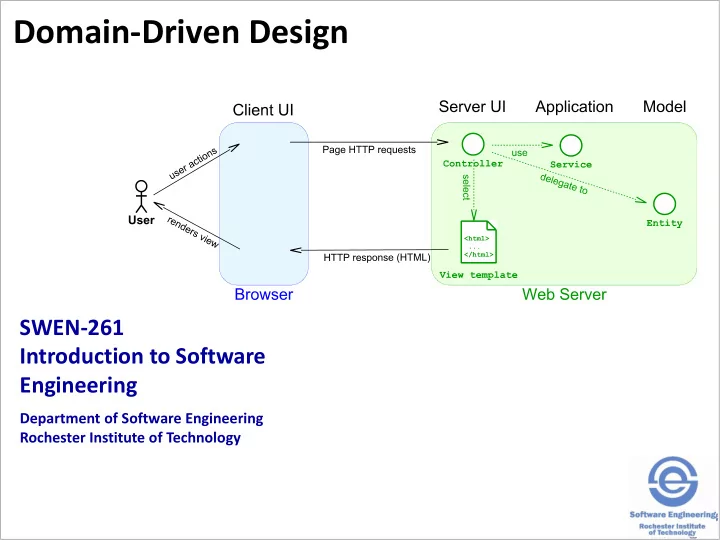

Domain-Driven Design SWEN-261 Introduction to Software Engineering Department of Software Engineering Rochester Institute of Technology
Domain driven design centers the architecture on the problem domain. Quote from the DDD Community: Domain-driven design (DDD) is an approach to developing software for complex needs by deeply connecting the implementation to an evolving model of the core business concepts The premise: • Place the project’s primary focus on the core domain and domain logic • Base complex designs on a model • Initiate a creative collaboration between technical and domain experts to iteratively cut ever closer to the conceptual heart of the problem 2
Let's review our project architecture. Client UI Server UI Model Application Network Connection What goes in these two tiers? HTML, CSS Spark & Frameworks & JavaScript FreeMarker Any Java Browser Platform Web server (Jetty) Any Any OS and HW OS/HW OS/Hardware 3
DDD provides guidance for the remaining tiers. Client UI Server UI Model Application Network Connection HTML, CSS Spark & Frameworks & JavaScript FreeMarker Any Java Browser Platform Web server (Jetty) Any Any OS and HW OS/HW OS/Hardware 4
Services provide application logic. The Application tier is responsible for managing the user's interaction with the application. It is not responsible for domain logic which is in the Model layer. Application tier elements provide services to each client connection. • Manage application-wide logic and information • Provide client-specific services for the UI tier 5
Entities provide domain logic. The Model tier is responsible for managing domain entities and domain logic. Entity responsibilities are: • Process user requests/commands • Effect changes based on user requests/commands • Validate Model-tier rules • Maintain the state of the Model Entities often represent information about the world, and are inspired by domain model entities • Customers, products and orders in e-commerce • Shapes in a drawing app 6
Value objects provide values for an entity's "complex" attributes. A value object class encapsulates the data that represents an entity's attribute. • Measurements, dates, credit card numbers, money, colors, (x,y) coordinates are some examples. • Two value objects are equal based on equality of the data in the object not object identity. Value objects must be immutable. • An address of 15 N. Main St cannot be changed into 352 2 nd Ave. • You create a new address object of 352 2 nd Ave. A value object class is not just a data holder class. • Value Object = "value semantics" + immutability + GRASP Information Expert, ref. Flight class in OOD I 7
Model objects are frequently used in collections. Many of the algorithms used in Model and Application components require using Entities and Value Objects in hash-based collections. Normal Java equality semantics are not adequate when dealing with Entities and VOs • An Entity must have a distinct id such that two objects with the same id must be considered equal. • Two Value Objects with the same data must be equal. • These semantic requirements imply specialized equals and hashCode methods. The after-class exercise provides instructions on how to create these methods. 8
A semantically correct value object can be used as a key in a map collection. Rather than extracting attributes from the value object to create a key, use the value object directly. This will work correctly because • The value object is immutable other code with a reference to the object can not change the object's value while it is in the map as a key • The equals and hashCode methods ensure that two objects with the same value will be considered equal and generate the same hash code. 9
Let's review the architecture again. 10
This is the list of component responsibilities. UI Tier Application Tier Model Tier UI Controller: Service: Entity: • Control the views based on the state of the • Manage application-wide • Process user requests/commands • application logic and information Effect changes to the Model based • Query the Model and Application tier as • Provide client-specific on user requests/commands • necessary to get information to present to the services to the UI tier Validate model rules • user Maintain the state of the model • Perform simple input validation and data conversion based on input modality, e.g. Value Object: String to integer • Initiate processing of user • Provide immutable value requests/commands possibly providing data semantics • the user input Provide value-based logic • Perform data conversion for display by views UI View: • Provide an interface to the user • Present information to the user in a variety of ways • Provide a mechanism for user to input data and requests 11
Recommend
More recommend